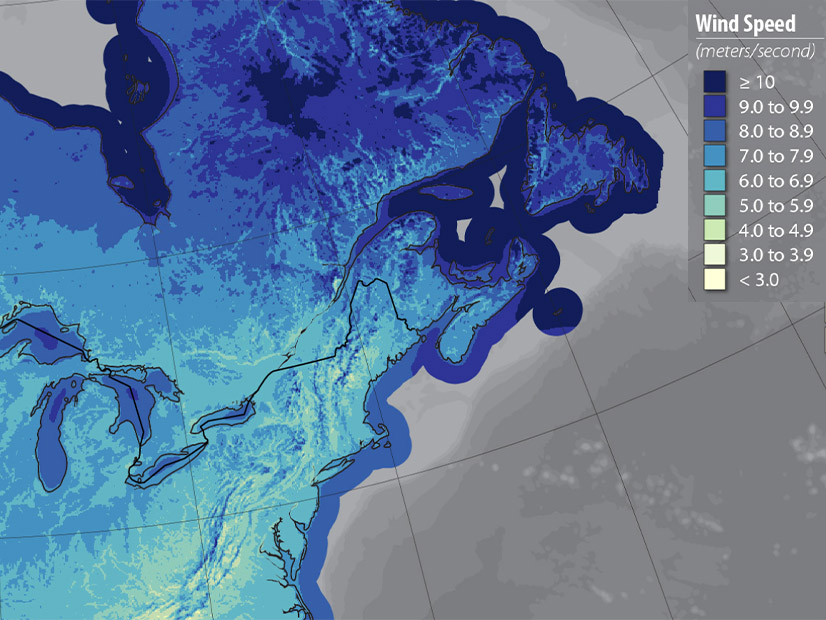A proposed transmission project to relieve transmission constraints in Maine has received a major boost with the U.S. Department of Energy’s announcement of an up-to $425 million investment in the project.
The funding for Avangrid’s Aroostook Renewable Project stems from DOE’s Transmission Facilitation Program, which on Oct. 2 awarded up to $1.5 billion for four projects across the country. (See related story, DOE Funding 4 Large Tx Projects, Releases National Tx Planning Study.) The department would serve as an anchor off-taker for the transmission capacity of the projects, with the goal of de-risking development and increasing outside investment.
Northern Maine is not currently interconnected with ISO-NE, limiting the development of renewables in the area despite high wind speeds and a large amount of undeveloped land.
“Unlocking the enormous wind resource in Aroostook County will deliver economic benefits to this important region of the state and is a necessary step toward Maine becoming energy independent by freeing our residents from the stranglehold of expensive and unreliable oil and gas,” the Natural Resources Council of Maine said in response to the announcement.
“Transmission line development and the ability to connect clean, affordable energy to the New England power grid is one of the most effective tools available to combat climate change while also enabling a stronger, 21st century economy,” Avangrid CEO Pedro Azagra said.
Gov. Janet Mills (D) applauded the Biden administration for the “unprecedented investment” and called the announcement “an exciting step forward and a testament to the tremendous energy opportunity available in Northern Maine.”
Looming Challenges
To unlock renewable development in the northern part of the state, the Maine Public Utilities Commission is planning separate solicitations of transmission capacity and renewable generation. Avangrid’s project would need to be selected by the PUC to proceed with development. The company expects the commission to announce the winning bids in 2025.
Transmission development in New England has faced significant challenges in recent years, and DOE’s support of Avangrid’s project is no guarantee of success.
The PUC’s solicitations come after a previously selected project by LS Power was terminated in December by the commission after the company requested an unspecified price adjustment. LS Power said it could no longer proceed with the fixed price it bid into the solicitation because of delays associated with negotiating contracts with Massachusetts and pressures from inflation, interest rates and supply chain distributions (2021-00369).
LS Power’s project was selected in conjunction with a 1,000-MW wind project by Longroad Energy. According to a study commissioned by LS Power, the projects would have saved Maine ratepayers nearly $900 million over the life of the contracts through lower electricity prices.
Following the solicitation, the Massachusetts Department of Energy Resources found it would be beneficial for the state’s electric utilities to contract for up to 40% of the generation and renewable energy certificates from the wind project and up to 40% of the line’s transmission service.
The DOER’s authority to participate in the multistate solicitations for transmission expired at the end of 2022, but Massachusetts Gov. Maura Healey (D) included language in a recently introduced budget bill to extend this authority through 2027. (See Mass. Gov. Healey Includes Permitting Reform in Budget Proposal.)
“Our region needs to buy more clean power and retain our existing clean resources to ensure reliability and advance our clean energy transition,” DOER spokesperson Lauren Diggin said. “Massachusetts will continue to seek out opportunities to partner with other states for our collective benefit.”
A spokesperson for Longroad Energy said the company understands why Maine opted to rebid the transmission and generation solicitations, but they said its wind proposal “will be a pivotal investment in Northern Maine and the largest, cheapest source of new clean energy in New England.”
DOE previously agreed to be an off-taker for National Grid’s Twin States Clean Energy Link Project, a proposed bidirectional transmission line connecting New England and Quebec via Vermont and New Hampshire. But despite the federal support, National Grid backed out of the project in March. (See National Grid Backs out of Twin States Clean Energy Link Project.)
Avangrid’s New England Clean Energy Connect (NECEC) project, currently under construction in Eastern Maine, has dealt with significant delays and a roughly 50% cost increase following legal and political challenges, which were heavily funded by incumbent fossil generators. When in service, the NECEC line will allow for the import of Quebec hydropower procured by Massachusetts. (See Avangrid Details Progress on NECEC Tx Line.)
Beyond connecting Northern Maine to the rest of ISO-NE, additional work likely looms to ease transmission constraints between Maine and load centers in Southern New England. In its 2050 Transmission Study, ISO-NE found that the interface between Maine and New Hampshire is likely to face overloads starting in 2035.
Unlocking access to large-scale renewable generation in Northern Maine could put more pressure on these interfaces, while the locations of offshore wind interconnections will also be a major factor in the timing and intensity of potential overloads. (See ISO-NE Analysis Shows Benefits of Shifting OSW Interconnection Points.)
“While the total generation in northern New England is a factor in these overloads, the precise locations of particular generator interconnections in Maine do not affect the probability that the overloads will occur; most of the power generated in this subregion still ultimately flows down through the major lines leading into Massachusetts,” the study found.



Avangrid’s project is Aroostook Renewable Project. LS Power’s project is Aroostook Renewable Gateway.